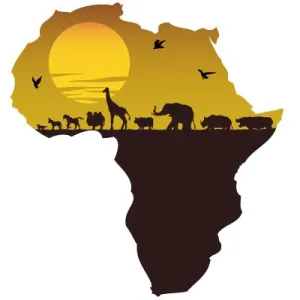Her får du muligheden for at komme i kontakt med en masse forskellige Afrikanske lande og med flere forskellige Modes. 24 timer den 18-19 marts

The South African Radio League Die Suid-Afrikaanse Radioliga
Africa All Mode International DX Contest
1. Aim
The objective of this all-mode contest is to stimulate contesting from Africa. All participating stations worldwide may work any country during the contest period. African DXCC entities are defined as those valid per the ARRL DXCC AF listing published at the time of the contest.
2. Date
12:00 UTC on Saturday 18 March 2023 to 12:00 UTC on Sunday 19 March 2023. Both single and multi-operator stations may operate for the entire 24-hour period. There are no mandated breaks in operating time required.
3. Bands
160, 80, 40, 20, 15 and 10 metres, in accordance with your country and specific licensing requirements governing the portion(s) of these bands that you may use. No contest QSOs are allowed on 12, 17, 30 or 60 metres.
4. Modes
CW, RTTY and SSB. Contestants may elect to enter a single mode category (where offered – see “Entry Categories” below) or take part as a mixed-mode entrant. Mixed-mode entrants may work the same station once on each mode per band (see “Entry Categories” for more details).
5. Log Submissions and Deadlines
No paper entries will be accepted for contest or checking purposes. Entries must be submitted in Cabrillo format only and be received no later than 15 days after the contest – Monday 3 April 2023. Entries must be sent to contest@sarl.org.za
6. Awards
Posted certificates will be awarded, printed and sent to:
- The highest scoring entrant in each category for the contest
- The highest scoring entrant in each category per continent
- The highest scoring entrant overall (any category) per ITU zone d.
- The overall top Rookie score each year per continent
Electronic certificates will be awarded and emailed to:
- The first and second place entrants in each category from each entity entered
7. Results
Results will be posted on the South African Radio League website at www.sarl.org.za two months after the entry deadline.
8. Entry Categories
For all categories, the use of spotting nets and skimmers are permitted. For all cate- gories, there are no restrictions on the number of band or mode changes made in any given period during the contest. Contestants may only submit their log in one of the 18 categories available.
Single Operator Single Transmitter
1.1. Single band
1.1.1. Phone only, high, low and QRP power levels
1.1.2. CW only, high low and QRP power levels
1.1.3. RTTY only, high low and QRP power levels
1.1.4. Mixed mode, high low and QRP power levels
1.2. All band
1.2.1. Phone only, high, low and QRP power levels
1.2.2. CW only, high low and QRP power levels
1.2.3. RTTY only, high low and QRP power levels
1.2.4. Mixed mode, high low and QRP power levels
One person performs all operating and logging functions and without exception, only one transmitted signal is allowed at any given time. Mixed mode entrants may work a station once per mode per band.
B. Single Operator Two Radio
2.1. Single mode all band, low power
2.2. Single mode all band, high power
2.3. Mixed mode all band, high power
2.4. Mixed mode all band, low power
Multi Operator Single Transmitter
3.1. Single band
3.1.1. Mixed mode high power
3.1.2. Mixed mode low power
3.2. All band
3.2.1. Mixed mode high power
3.2.2. Mixed mode low power
Multi Operator Multi Transmitter
4.1. Mixed mode all band, high power
4.2. Mixed mode all band, low power
All Multi-op efforts must enter the mixed mode category. There is no multi-op or SO2R QRP power level. Stations may be worked once per mode per band. In all categories, cross-mode, cross band and repeater contacts is not allowed.
9. Categories Eligible for Rookie Awards
The rookie awards in the AMA contest aim to reward individual rather than team efforts, which show flexibility and skill in operating procedure for recently licensed amateurs. They are available for the categories of 1.1.4 and 1.2.4. You are eligible to mark your log submission as a rookie entry if you were licensed for the first time on, or less than two years prior to, the contest date. If you enter one of the rookie categories, you may not enter a different category in the same contest. It is not mandatory to enter as a rookie if you qualify as such, you may also elect to enter any of the non-rookie categories.
10. Contest Exchange
The exchange is your RS(T) (not checked during the log checking process), followed by an incremental serial number commencing at “001”. Changing modes or bands does not necessitate different serial number ranges, i.e., the serial number simply progresses from “001” upwards sequentially as you log QSOs in any category, for single or multi-op efforts. A complete exchange, consisting of an RS(T) and serial number, must be logged for each QSO.
Each QSO claimed for competition credit must comply with the rules found under 15. General Rule "5. Contacts".
11. Power Levels
For the purposes of this contest, all entrants must adhere to the power levels (ex- pressed as Peak Envelope Power, or PEP) as set out below when determining their entry category. Additionally, all entrants must adhere to their specific licensing requirements regarding permitted power and other regulations, which take precedent over the contest-defined power levels when operating in the contest.
- QRP is defined as 5 watts PEP or less as measured at the antenna port at the transmitter, or power amplifier (if used).
- Low power is defined as more than 5 watts PEP but not more than 100 watts PEP measured at the antenna port either at the transmitter, or power amplifier (if used).
- High power is defined as more than 100 watts PEP but not more than 1 500 watts PEP measured at the antenna port either at the transmitter, or power amplifier (if used).
12. Points, multipliers and scoring
Points - All QSO’s are awarded 1 point.
Band multiplier
The band multiplier is determined on a band-by-band basis.
The band multiplier increments by one for every AF-DXCC entity worked, for each of the three operating modes: CW, SSB and RTTY.
Band score
Band score is simply the band points multiplied by the band multiplier. Band score = (band points) X (band multiplier)
Total score
Total score is simply the sum of all the band scores.
Total score = 10 m band score + 15 m band score + 20 m band score + 40 m band score + 80 m band score + 160 m band score
13. AF Entity Definition
- For the purposes of this contest, Africa entities are considered as per the standard
- ARRL DXCC AF list as published at the time/year of the contest currently taking
- Ship-based and aeronautical stations only count 1 point when worked and do not count as multipliers regardless of them being in international or territorial waters during the contest period.
14. Cabrillo Information
QSO: Required information fields and format.
QSO: freq mo date time call rst exch call rst exch t
15. General
- Conditions of Entry: Each entrant agrees to be bound by the provisions set out in this docume The decisions of the South African Radio League Contest Committee are final and binding.
- The use of self-spotting on packet via any means is inconsistent with the spirit and intent of this contes
- The use of non-amateur radio means of communications (e.g., telephone or internet) for soliciting a contact during the contest period is inconsistent with the spirit and intent of this contes
- Where contest-preferred segments are incorporated into regional band plans, entrants must observe th
- Penalties and disqualifications: participants breaching the provisions as set out in this document may be subject to a point deduction as decided by the contest committee, or in serious cases disqualific
- Duplicate QSOs will not attract any penalties but will also not count for additional points.
- All transmitters and receivers must be located within a 500-metre diameter circle, excluding antenn
- The use of remote receiving or transmitting installations outside of your own entity is prohibit


